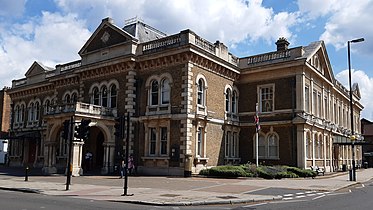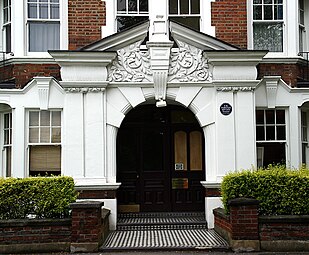Turnham Green
| Turnham Green | |
|---|---|
 | |
Location within Greater London | |
| Population | 11,448 (2011 Census. Ward)[1] |
| OS grid reference | TQ212786 |
| London borough | |
| Ceremonial county | Greater London |
| Region | |
| Country | England |
| Sovereign state | United Kingdom |
| Post town | LONDON |
| Postcode district | W4 |
| Dialling code | 020 |
| Police | Metropolitan |
| Fire | London |
| Ambulance | London |
| UK Parliament | |
| London Assembly | |
Turnham Green is a public park on
The green is the site of local community events, including a
The nearest London Underground station is Chiswick Park on the District line.
Turnham Green tube station is on Chiswick Common, the site in 1642 of The Battle of Turnham Green.
History
Turnham Green was a village on the main road between London and the west. It was recorded as 'Turneham' in 1235 and 'Turnhamgrene' in 1369.[3]
On 13 November 1642, the Battle of Turnham Green was fought nearby during the First English Civil War resulting in the Parliamentarians blocking the King's advance on London.[4]
In 1680 the homicidal
From 1912 until its closure in 1959, the Chiswick Empire theatre stood facing the north side of Turnham Green.[7]
-
Reenactment of the 1642 Civil War Battle of Turnham Green
-
TheOld Packhorse, 1910, replacing an earlier building
-
Chiswick Empire theatre, 1913
Buildings
At the eastern end of the green stands Chiswick war memorial. It is in the form of a stone obelisk at the top of a flight of five steps, encircled by a metal fence and a yew hedge. It was unveiled on 13 November 1921 by the 9th Duke of Devonshire and Arthur Winnington-Ingram, the Bishop of London. It is made of Cornish granite. It was designed by a local architect, Edward Willis. It was given Grade II listed status in 2015.[8]
In the middle of the green stands the tall
Along the southern side of the green is Heathfield Terrace; its largest buildings are the Italianate 1876
In 2021, Hounslow Council reappraised the Turnham Green Conservation area.[12] This is adjacent to the Chiswick High Road conservation area (which is further east), covering the part of the High Road from Chiswick Road in Gunnersbury to the west, via the whole of Turnham Green common and the buildings facing its north side along the High Road, to Clifton Gardens in the east. It takes in a substantial area to the south of the common, and was extended in 2019 to include the streets between Sutton Court Road and Duke's Avenue down to the Great West Road.[12]
-
Fromow's Corner, 1889
-
Former Army and Navy Furniture Repository, Heathfield Terrace, c. 1900
-
Chiswick Town Hall, Heathfield Terrace, 1876
-
Turnham Green Church Hall, 1913, now used as a school
-
Chiswick War Memorial, 1921, looking west across Turnham Green
In culture
Highwayman
The 18th century highwayman broadside ballad "Alan Tyne of Harrow" includes the couplet:[13]
- "One night by Turnham Green I robbed a revenue collector,
and what I took from him I gave to a widow to protect her".[13]
- "One night by Turnham Green I robbed a revenue collector,
Charles Dickens's novel A Tale of Two Cities, set in the time of the French Revolution at the end of the 18th century, mentions "that magnificent potentate, the Lord Mayor of London, [who] was made to stand and deliver on Turnham Green, by one highwayman, who despoiled the illustrious creature in sight of all his retinue."[14]
Other mentions
The song "Suite In C" on the eponymous album McDonald and Giles, which alludes to places in London, includes the line "The sun shone 'til Turnham Green".[15]
The song "Junkie Doll" by Mark Knopfler includes the line "Turnham green, Turnham green, You took me high as I've ever been".[16]
Residents
- abolitionist, was born here in 1799.[17]
- Peter Brook, director, born here in 1925 and grew up at 27 Fairfax Road.[18]
- Frank Field, politician, was a Labour councillor for Turnham Green from 1964 to 1968.[19]
- E. M. Forster, novelist, lived at 9 Arlington Park Mansions on Turnham Green[20] from 1939 until at least 1961.[21]
- Ugo Foscolo, Venetian writer and poet, key figure of Italian Neoclassicism and Romanticism, died here in 1827.[22]
- Patsy Hendren, (1899-1962), cricketer, was born here.[23]
- Harold Hume Piffard, amateur pioneer aviator, built a plane in 1909 in a shed on Back Common Road[24]
- The painter Vincent van Gogh spent three years in Chiswick in the 1870s, teaching Sunday school pupils in the newly-constructed Chiswick Congregational Church, which was on the site of the Arlington Park Mansions on Turnham Green; he wrote of Chiswick as a "verdant" district of London.[25][26][27]
-
The Italian poet Ugo Foscolo, who died in exile here,
by F.-X.-P. Fabre, 1813 -
Sketch of Turnham Green Congregational Church by Vincent van Gogh, c. 1875. He taught Sunday school in the iron structure, now replaced by Arlington Park Mansions.[27]
-
Arlington Park Mansions on Sutton Lane North, facing Turnham Green, with E. M. Forster blue plaque
-
The theatre director Peter Brook was born here.
References
- ^ "Hounslow Ward population 2011". Neighbourhood Statistics. Office for National Statistics. Retrieved 24 October 2016.
- ISBN 978-1-86077-269-6.
- ISBN 0-948667-96-6.
- ^ Robinson , Wayne. "The Battle of Turnham Green, November 13, 1642"/ 29 April 2010. — official site of The Pike and Musket Society
- ^ David L. Smith, 'The infamous seventh earl of Pembroke, 1653–1683' (a sub-section of 'Herbert, Philip, first earl of Montgomery and fourth earl of Pembroke (1584–1650), courtier and politician') in Oxford Dictionary of National Biography (OUP, 2004)
- ISBN 978-0-7171-5156-1.
- ^ Pain, Christina (2001). "The Chiswick Empire". Brentford and Chiswick Local History Journal (10).
- ^ Historic England. "Chiswick War Memorial (1424996)". National Heritage List for England. Retrieved 5 December 2017.
- ^ Bolton, Diane K.; Croot, Patricia E. C.; Hicks, M. A. (1982). Baker, T. F. T.; Elrington, C. R. (eds.). A History of the County of Middlesex: Volume 7. London: Victoria County History. pp. 90–93.
- OCLC 24722942.
- ^ Clegg, Gillian. "Business". Gill Clegg's Chiswick History Web Pages. Retrieved 16 July 2021.
- ^ a b c d "Turnham Green Conservation Area Appraisal". London Borough of Hounslow. January 2021. Retrieved 30 July 2021.
- ^ a b "(Alan) Tyne of Harrow / Valentine O'Hara". Mainly Norfolk: English Folk and Other Good Music. Archived from the original on 8 July 2017. Retrieved 11 May 2018.
- ^ Dickens, Charles, A Tale of Two Cities Book I, ch. 1.
- ^ McDonald, Ian; Giles, Michael. "McDonald and Giles - Suite in C Lyrics". SongLyrics. Retrieved 11 May 2018.
- ^ Knopfler, Mark. "Junkie Doll". Retrieved 19 June 2018.
- ^ The American quarterly register, American Education Society, 1841, p200, accessed April 2009
- ISBN 978-1-4088-5228-6. Retrieved 20 July 2015.
- ^ "London Borough of Hounslow Election Results 1964-2010" (PDF). Elections Centre. Archived (PDF) from the original on 30 August 2018. Retrieved 19 September 2019.
- ISBN 9781408824276.
- ^ "E.M. Forster 9 Arlington Park Mansions, Sutton Lane, Chiswick, London". Notable Abodes. 2011. Retrieved 23 May 2013.
- ^ Gentleman's Magazine and Historical Review Volume 97, Part 2. 1827. pp. 566–569. Retrieved 21 May 2013.
- ^ "England / Players / Patsy Hendren". ESPN. Retrieved 14 November 2018.
- ^ Manton, Colin (2006). "Harold Piffard of Bedford Park, Artist and Aviator Extraordinaire". Brentford & Chiswick Local History Journal. 15. Archived from the original on 1 November 2019. Retrieved 1 November 2019.
- ^ "Wall Street Journal Tells Readers to Pay a Visit to Chiswick: Describes it as a lush paradise that inspired Van Gogh". Chiswick W4. 2 July 2023. Retrieved 3 July 2023.
- Wall Street Journal.
More than pretty gardens draw people to this leafy suburb. The other lures: trendy gastropubs, cheese toasties and the haunting traces of centuries of artists and writers.
- ^ a b Clegg, Gillian (2001). "Van Gogh In Chiswick". Brentford and Chiswick Local History Society. Retrieved 3 July 2023.












![Sketch of Turnham Green Congregational Church by Vincent van Gogh, c. 1875. He taught Sunday school in the iron structure, now replaced by Arlington Park Mansions.[27]](http://upload.wikimedia.org/wikipedia/commons/thumb/4/4c/Sketch_of_Turnham_Green_Congregational_Church_by_Vincent_Van_Gogh_c1875.jpg/364px-Sketch_of_Turnham_Green_Congregational_Church_by_Vincent_Van_Gogh_c1875.jpg)





